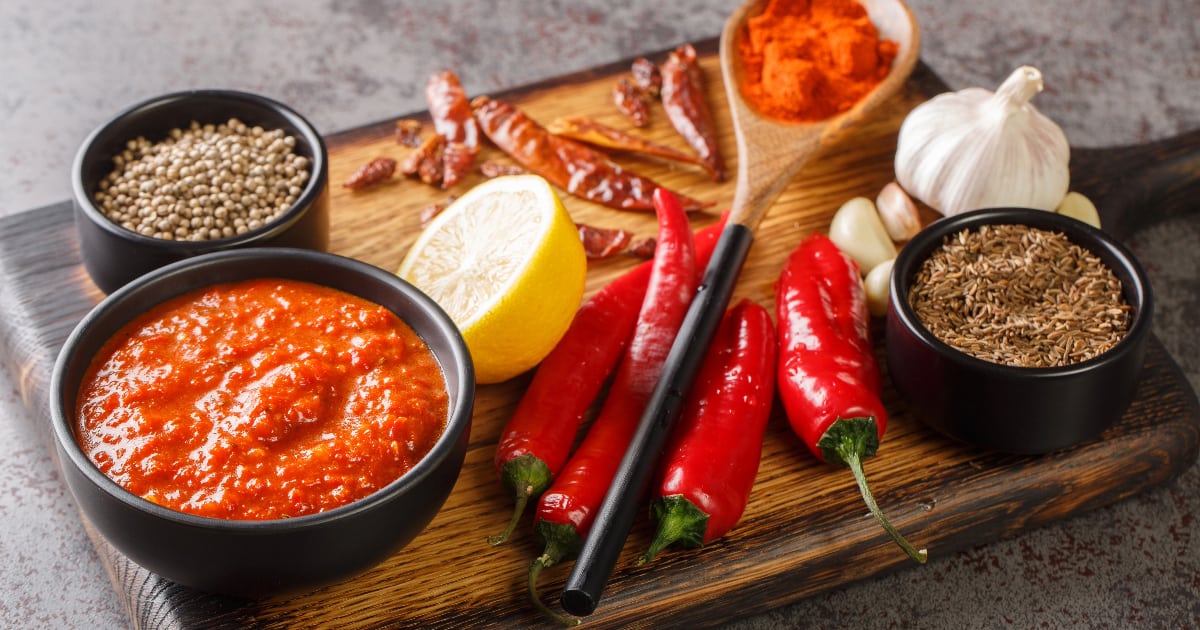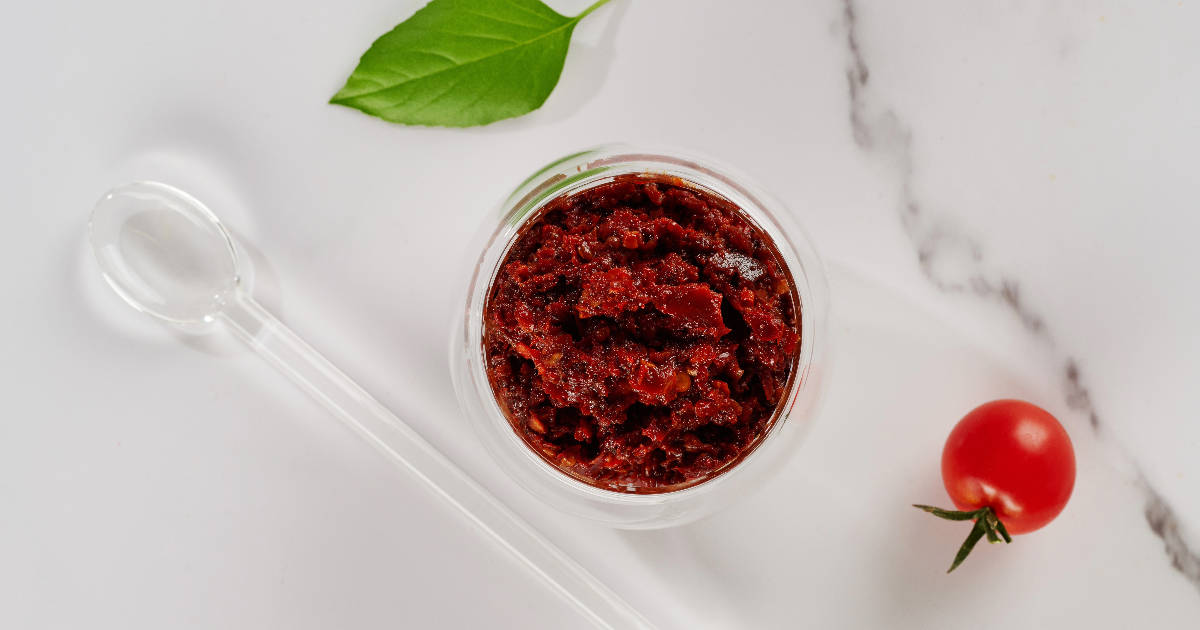Harissa paste is a fiery North African condiment that can add delicious flavor and heat to many dishes.

Making your own harissa paste at home is easy and allows you to control the spice level.
With just a few simple ingredients like dried chilies, spices, garlic, oil, and acid, you'll have a tasty homemade harissa in no time.
Gather the Harissa Paste Ingredients
To make harissa paste, you'll need:
- Dried red chiles like guajillo, New Mexico, arbol or puya. Using a combination provides depth of flavor.
- Garlic - 4-8 cloves add flavor. Roast for a milder taste.
- Olive oil - Helps bind ingredients. Use extra virgin for the best flavor.
- Spices - Toast cumin, coriander and caraway seeds then grind into powder.
- Acid - Lemon juice adds brightness. Can also use vinegar.
- Salt - A pinch balances flavors.
- Tomato paste - Provides richness and color.
Optional extras like smoked paprika, cayenne, mint, and cilantro also add unique flavors.
Make the Harissa Paste

Making homemade harissa paste is simple:
- Soak dried chiles in boiling water for 30 minutes until softened.
- Drain chiles then remove stems and seeds. Rinse.
- Toast whole spices in a dry skillet until fragrant. Grind into powder.
- Add all ingredients to a food processor. Blend into a smooth paste, adding oil slowly.
- Adjust flavors as needed. Add more lemon juice for acidity or salt to taste.
- Store paste in a jar topped with a thin layer of olive oil to preserve it. Refrigerate for up to 1 month.
Adjust the Heat
The type of chiles you use determines the heat level. For mild harissa:
- Use more mild dried chiles like Guajillo or New Mexico.
- Remove seeds from spicy dried chiles before adding.
- Start with small amounts of hot chiles like arbol or bird's eye.
- Omit cayenne pepper or chili powder if you don't want much heat.
Play with Flavor
Customize your homemade harissa to suit your tastes:
- Smoky - Add smoked paprika or chipotle chiles.
- Sweet - Stir in a bit of honey or maple syrup.
- Savory - Use more cumin, garlic, or tomato paste.
- Citrusy - Increase the lemon juice.
- Herby - Throw in cilantro, mint, or parsley.
- Earthy - Add a pinch of cinnamon or clove.
How to Use Harissa Paste
Homemade harissa paste is extremely versatile. Use it to add flavor and heat to:
- Meats - Rub on chicken, beef, or lamb before grilling.
- Seafood - Delicious on fish, shrimp, or mussels.
- Veggies - Tossed with roasted veggies or potatoes.
- Dips - Swirl into hummus, yogurt dips, or mayo.
- Salad dressings - Whisk with oil and vinegar.
- Soups and stews - Stir in a spoonful to add depth.
- Eggs - Add flair to scrambled eggs or shakshuka.
- Sandwiches - Spread on meats or toast for a kick.
Make Quick Harissa Paste
For fast harissa, use jarred roasted red peppers instead of rehydrating dried ones. Simply blend peppers with spices, garlic, oil, lemon and salt.
You can also mix harissa paste flavors using ground spices like:
- Smoked paprika
- Chili powder
- Cayenne pepper
- Cumin
- Garlic powder
- Salt
While not completely authentic, quick harissa still packs delicious flavor!
Store and Freeze Leftover Harissa
Did you make too much harissa paste? Here are storage tips:
- Short-term - Refrigerate harissa in an airtight container for up to 3 weeks. Cover with a layer of oil.
- Long-term - Freeze harissa paste for up to 2 months. Freeze in ice cube trays or small batches.
- Thaw - Defrost frozen harissa overnight in the refrigerator before using.
Stay Safe When Handling Chilies
When working with fresh hot chilies:
- Avoid direct contact by wearing gloves while handling.
- Wash hands, utensils, and surfaces after contact with chilies.
- Avoid touching your eyes and face during prep.
- Remove chili seeds to reduce heat levels.
FAQ
What is the difference between harissa paste and sriracha?
Harissa has a thicker, more paste-like consistency compared to the runnier sriracha sauce. It also tends to have a deeper, more complex flavor thanks to ingredients like toasted spices, garlic, and olive oil. Sriracha gets its heat from chili peppers, sweetness from sugar, and tang from vinegar.
Can you make a quick harissa paste with jarred roasted peppers?
Yes, using jarred roasted red peppers is an easy shortcut for making quick harissa paste. Just skip rehydrating the dried peppers. Blend the roasted peppers with your spices, garlic, oil, lemon juice, and salt. While not completely authentic, it still captures delicious harissa flavor.
What kind of jar should I use to store homemade harissa paste?
An airtight glass jar with a tight-fitting lid works best for storing harissa paste. Make sure to cover the entire surface of the paste with a thin layer of olive oil before sealing it to help preserve it in the refrigerator. Any remaining air in the jar could compromise freshness.
How long does homemade harissa paste last in the freezer?
Properly stored in a freezer-safe container, homemade harissa paste will be kept for up to 2 months in the freezer. To extend shelf life, freeze harissa in small batches like ice cube trays. Defrost cubes overnight in the fridge before using.
Can I substitute different dried chilies when making harissa paste?
Absolutely! The variety of dried chilies used is flexible based on what you have available and your desired heat level. Some good options are guajillo, New Mexico, arbol, puya, ancho, pasilla and mulato. Mixing chilies creates depth. Just remember to remove seeds from hotter ones to reduce heat.
Is it necessary to use a food processor for making harissa paste?
While a food processor makes quick work of blending the ingredients into a smooth paste, you can also use a mortar and pestle. This traditional technique will require some elbow grease but still produce great homemade harissa. Just be patient and keep mashing and grinding the ingredients together.
Conclusion
Making your own harissa paste is easy, customizable, and adds incredible flavor to meals!
Follow this guide for how to make authentic-tasting harissa using spices you likely have in your pantry already.
Adjust the heat to your personal tolerance and experiment with extra flavors.
In no time, you'll have a tasty homemade condiment ready to spice up dips, dressings, meats, seafood, and more!

